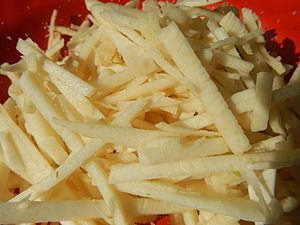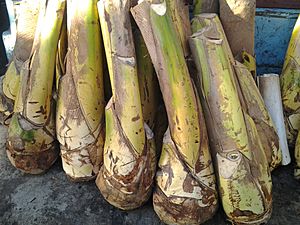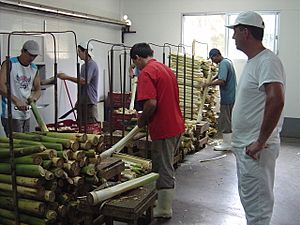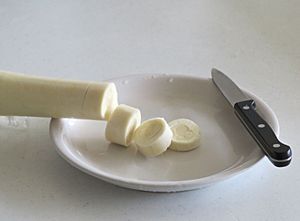Heart of palm facts for kids

Heart of palm is a tasty vegetable that comes from the inside of certain palm trees. It's the soft, white core found deep within the tree's growing tip. You can find heart of palm from trees like the coconut, açaí palm, and peach palm.
When people harvest heart of palm from some wild palm trees, it can unfortunately kill the tree. However, some palm types grow many stems, like a bush. With these, you can harvest some stems without harming the whole plant. The peach palm is a great example. It grows many stems and has been specially grown to have no thorns.
Heart of palm can be eaten on its own, but it's often used in a salad. Because it takes a lot of effort to harvest, it's considered a special food, also known as a delicacy.
Contents
Names for Heart of Palm
Heart of palm has different names around the world. In Florida and Trinidad, it's called palm cabbage or palmetto. In South and Central America, it's known as palmito.
The Philippines calls it ubod. In French, it's coeur de palmier, and in Spanish, corazón de palma or col de palma. Portuguese speakers say coração de palma or palmito, and in Italian, it's cuore di palma.
Healthy Benefits of Heart of Palm
Heart of palm is a healthy food choice! It's packed with good things your body needs. It has lots of dietary fiber, which helps your digestion.
It's also a good source of important minerals like potassium, iron, zinc, phosphorus, and manganese. You'll also find vitamins like B2, B6, and C.
Fresh heart of palm is naturally low in sodium. However, if you buy it canned, it often has added salt, so check the label!
Where Heart of Palm is Grown
People have been harvesting and eating heart of palm for a very long time. This tradition goes back before colonial times in places like Southeast Asia and South and Central America. The type of palm used depends on the region.

In Southeast Asia, the main source is the coconut. Other palms like rattans and fishtail palms are also used.

In Central and South America, popular choices include juçara palms, açaí palms, and pejibaye palms. Some wild palms were overharvested in the past. Now, many places focus on growing Bactris gasipaes (peach palm) on farms. This helps protect wild palm populations.
Growing heart of palm has also spread to other parts of the world, including South Asia and Africa.
As of 2008, Costa Rica was a major supplier of fresh palm hearts to the U.S. Peach palms are also grown in Hawaii. In Florida, the wild Sabal palmetto (cabbage palm) was once used, but it is now protected by law.
How Heart of Palm is Harvested
Harvesting heart of palm is a careful process. When a young palm tree is ready, it is cut down. Workers then remove the tough outer bark. This reveals many layers of white fibers wrapped around the center core.
These fibers are carefully removed until only the soft, edible center core remains. This core is attached to a slightly wider, more fibrous base. Both parts are good to eat. The very center core is considered the most special part because it's the tenderest.
See also
 In Spanish: Palmito (gastronomía) para niños
In Spanish: Palmito (gastronomía) para niños


